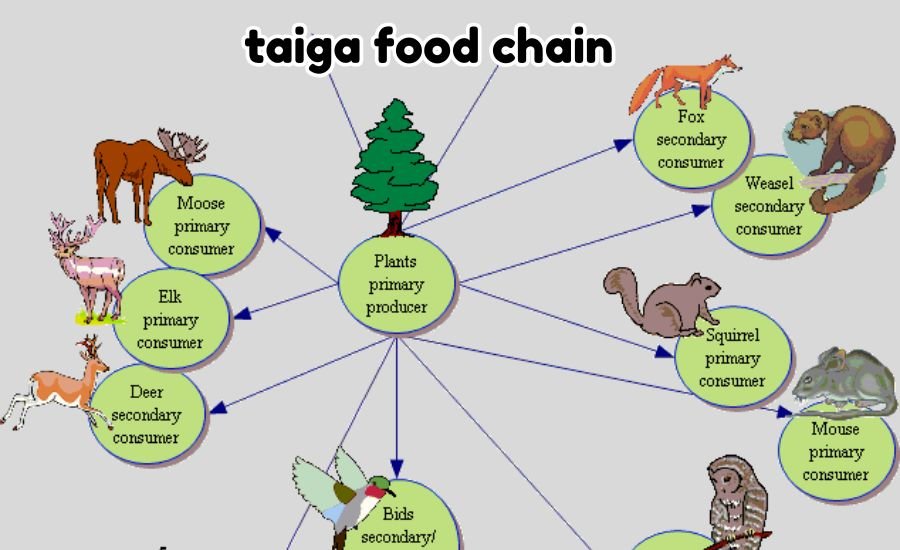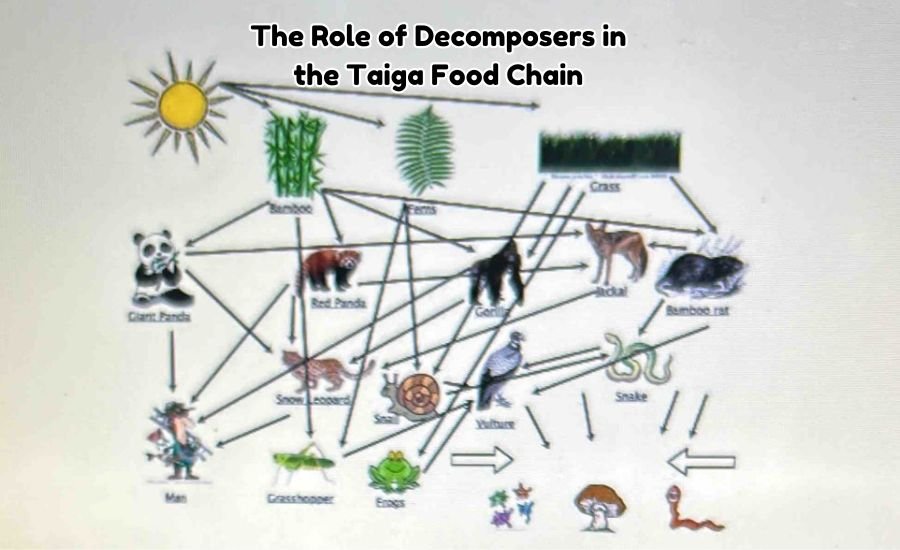The taiga food chain is a crucial part of the world’s largest land biome, the taiga, also known as the boreal forest. This biome stretches across North America, Europe, and Asia, covering vast areas of Canada, Russia, and Scandinavia. It is home to a diverse range of plants and animals that have adapted to extreme cold, long winters, and short summers.In this region, the taiga food chain consists of various organisms that interact with each other for survival.
It includes producers, primary consumers, secondary consumers, tertiary consumers, and decomposers. The harsh environment makes food availability limited, so each organism plays a significant role in maintaining balance in the ecosystem.Understanding the taiga food chain is essential to learning how energy flows from one organism to another. Without this balance, the ecosystem would collapse, affecting biodiversity and the climate. Humans also play a role in preserving or disturbing this chain, making it crucial to study its impact.
The Role of Producers in the Taiga Food Chain

Producers are the foundation of the taiga food chain. They create their food through photosynthesis, using sunlight, water, and carbon dioxide. These organisms include coniferous trees like spruce, fir, and pine, along with mosses, lichens, and shrubs. They provide the primary source of energy for herbivores.Since the taiga has long, freezing winters and short growing seasons, plants have adapted unique survival techniques.
Many trees have needle-like leaves coated with a waxy layer to reduce water loss. Some, like mosses and lichens, can grow on rocks and withstand extreme cold.Without producers, the taiga food chain would not exist, as all energy starts with them. They are the first step in the cycle, supporting herbivores and indirectly feeding carnivores and omnivores. Their role is vital for the overall stability of the ecosystem.
| Producer Name | Importance in the Taiga Food Chain | Special Adaptation |
| Spruce Trees | Provide food and shelter for many animals | Needle-like leaves prevent water loss |
| Mosses & Lichens | Source of food for reindeer and small herbivores | Grow in extreme cold with little sunlight |
| Pine Trees | Support many species with seeds and needles | Produce cones that protect seeds |
| Birch Trees | Offer food and nesting spots for birds | Shed leaves to survive winter |
Primary Consumers in the Taiga Food Chain
Primary consumers are herbivorous animals that feed on plants. These animals are the second level of the taiga food chain and play a crucial role in transferring energy. They include species such as hares, moose, beavers, and caribou.Since food sources in the taiga are limited, these animals have developed adaptations to survive.
Some, like moose, can eat tough plants, while others, like snowshoe hares, change their fur color to blend into the snowy environment. Beavers build dams to create safe water habitats, while reindeer migrate long distances in search of food.Without primary consumers, the taiga food chain would break down, as predators would have no food to eat. These herbivores help control plant growth and serve as prey for secondary consumers.
| Primary Consumer | Diet | Adaptation for Survival |
| Snowshoe Hare | Bark, twigs, and leaves | Changes fur color to blend in winter |
| Moose | Aquatic plants and shrubs | Large body helps store fat for winter |
| Beaver | Tree bark and leaves | Builds dams for protection and food storage |
| Caribou | Moss, lichen, and grasses | Migrates to find food in different seasons |
Secondary Consumers: The Predators of the Taiga
Secondary consumers are carnivores and omnivores that hunt herbivores. They are the third level of the taiga food chain, helping control the population of primary consumers. Common secondary consumers in the taiga include wolves, lynxes, foxes, and owls.These animals have sharp senses, strong claws, and powerful teeth to catch prey.
Wolves hunt in packs to take down large animals, while lynxes rely on stealth and speed. Owls use their excellent night vision to spot prey in the dark.Secondary consumers maintain the balance of the taiga food chain. Without them, herbivore populations would grow too large and overconsume vegetation, damaging the ecosystem.
| Predator Name | Prey | Hunting Strategy |
| Gray Wolf | Deer, hares, and beavers | Hunts in packs to take down large prey |
| Lynx | Hares, birds, and rodents | Uses stealth and sharp claws to catch prey |
| Great Horned Owl | Small mammals and birds | Hunts at night using keen eyesight and silent flight |
| Red Fox | Rabbits, insects, and fish | Hunts alone using agility and speed |
Tertiary Consumers in the Taiga Food Chain
Tertiary consumers are the top predators in the taiga food chain. These animals have no natural enemies and regulate the population of secondary consumers. Examples include brown bears, wolverines, and golden eagles.These predators have powerful jaws, sharp claws, and high endurance. Bears are also omnivorous, eating berries, nuts, and fish.
Wolverines are known for their strength and ability to take down prey larger than themselves.Tertiary consumers are essential to maintaining balance in the taiga food chain. Their presence prevents the overpopulation of smaller predators, keeping the ecosystem healthy.
| Tertiary Consumer | Prey | Special Traits |
| Brown Bear | Fish, berries, and small mammals | Strong claws and ability to hibernate |
| Wolverine | Birds, rabbits, and deer | Powerful bite and endurance |
| Golden Eagle | Small mammals and birds | Sharp talons and excellent vision |
Essential Information: Hondurian-food-ultimate-guide-to-traditional-dishes-and-flavors
The Role of Decomposers in the Taiga Food Chain

Decomposers are essential for breaking down dead plants and animals, recycling nutrients into the soil. They complete the taiga food chain by ensuring that nutrients return to the earth, allowing new plants to grow.
Common decomposers in the taiga include fungi, bacteria, and insects. These organisms thrive in moist environments, though the cold slows down decomposition. Without them, dead matter would accumulate, disrupting the ecosystem.
| Decomposer | Role in the Taiga |
| Fungi | Breaks down wood and plant material |
| Bacteria | Decomposes dead animals and releases nutrients |
| Beetles | Helps in breaking down organic waste |
Conclusion
The taiga food chain is a delicate and complex system that keeps the boreal forest ecosystem balanced. From towering spruce trees to mighty wolves and decomposing fungi, every organism plays a role in energy transfer and survival.Human activities such as deforestation, hunting, and climate change threaten this natural balance.
Conservation efforts, including national parks and sustainable forestry, can help protect the taiga food chain for future generations.By understanding and respecting the taiga food chain, we can contribute to preserving this unique and valuable ecosystem for years to come.
What You Should Know: Halal-chinese-food-a-unique-blend-of-taste-and-tradition
FAQs
What is the taiga food chain?
The taiga food chain is the transfer of energy between organisms in the boreal forest, starting with plants and ending with top predators and decomposers.
What are the main producers in the taiga food chain?
Common producers include coniferous trees like spruce, pine, and fir, along with mosses, lichens, and shrubs that provide food for herbivores.
Which animals are primary consumers in the taiga?
Herbivores like moose, snowshoe hares, beavers, and caribou feed on plants and act as the first level of consumers.
What are the top predators in the taiga food chain?
Wolves, lynxes, golden eagles, and wolverines are top predators, helping regulate animal populations in the ecosystem.
How do decomposers contribute to the taiga food chain?
Decomposers like fungi, bacteria, and insects break down dead plants and animals, recycling nutrients into the soil.
Why is the taiga food chain important?
It maintains ecological balance by controlling populations, recycling nutrients, and supporting biodiversity in the forest.
What adaptations help animals survive in the taiga?
Many animals grow thick fur, hibernate, migrate, or change colors with the seasons to survive harsh winters.
How does climate change affect the taiga food chain?
Rising temperatures and habitat loss disrupt food availability, leading to population declines and imbalances in predator-prey relationships.
What happens if a species disappears from the taiga food chain?
The loss of one species can cause overpopulation or starvation in others, leading to ecosystem collapse.
How can humans help protect the taiga food chain?
Sustainable logging, wildlife conservation, and reducing carbon emissions can help preserve the delicate balance of the taiga ecosystem.